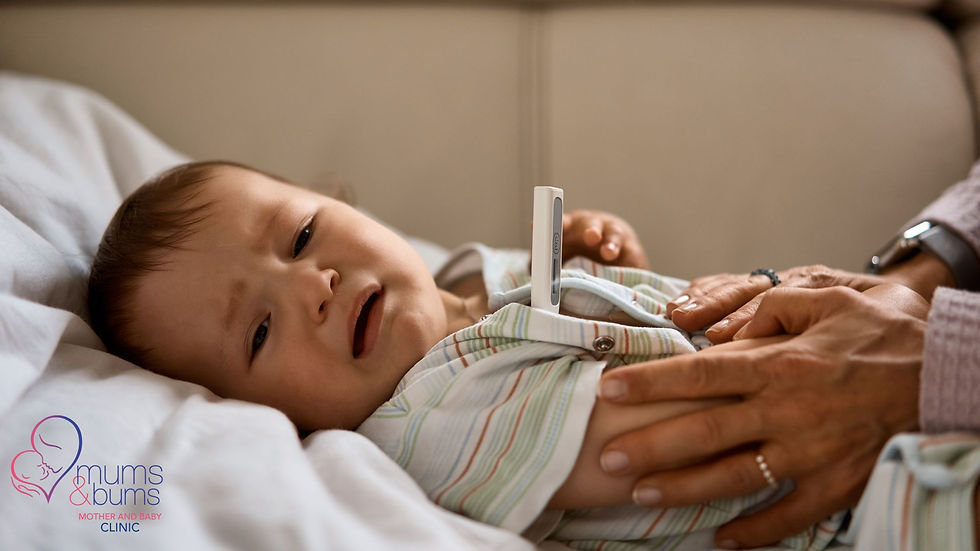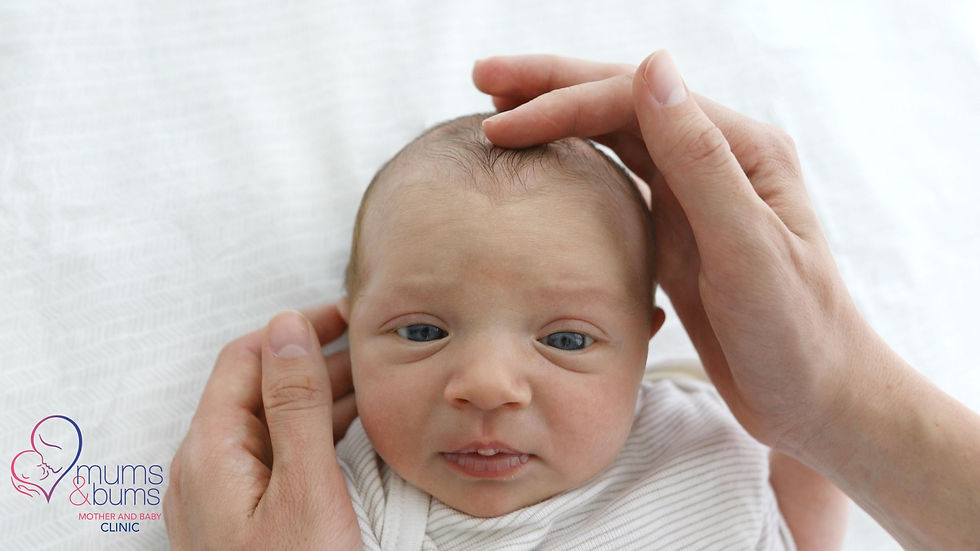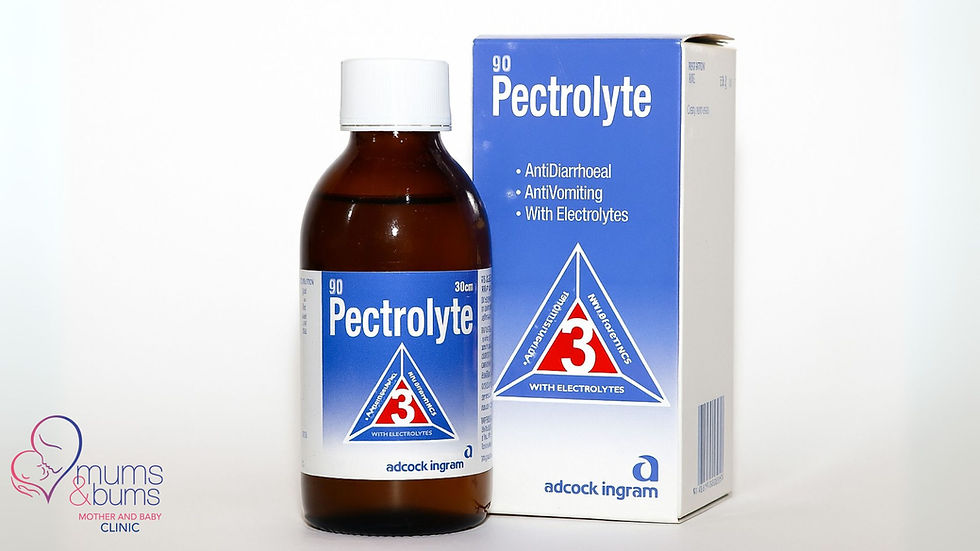Is Your Baby or Child Dehydrated? Urgent Signs & Home Care: The South African Guide
- Samantha Pieterse

- Aug 12
- 7 min read

Is your baby feeding less, crying without tears, or looking unusually sleepy?
Dehydration in little ones can develop quickly, and sometimes the signs aren’t apparent until it’s serious. Their tiny bodies can’t store reserves, meaning they can tip into dehydration faster, especially during hot South African summers or when they’re unwell.
At Mums & Mums, we see it often after tummy bugs, fevers, heatwaves, or breastfeeding difficulties. It’s not just diarrhoea or vomiting that can cause dehydration, but even mild illnesses that reduce feeding (or cause a fever), long car trips without regular breaks, or overheating in a pram can set it off. In very young infants, the progression from mild to severe dehydration can happen within hours, making early recognition and action really important.
But if you know the signs and act early, most cases can be treated quickly and safely at home or with a simple clinic visit. Here’s your parent-friendly, nurse-approved guide to spotting dehydration early, caring for your baby at home, and knowing when it’s time to get help.
Why Dehydration Happens in Babies & Toddlers
A baby or child can become dehydrated more easily than older children and adults because of the way their bodies manage water. At birth, up to three-quarters of a baby’s body weight is water, and this fluid is spread across a smaller body size. This means even a slight loss, from sweat, urine, or illness, represents a much bigger percentage of their total fluid volume.
Their kidneys are still immature, so they can’t concentrate urine as well as adults. As a result, they lose more water in their wee, even when their body needs to conserve it. Their metabolic rate is also higher, which means they use water faster to support growth and normal body functions.
On top of that, babies and toddlers can’t always tell you they’re thirsty, and they rely entirely on adults to offer fluids. If feeding is interrupted, whether by illness, teething pain, or feeding difficulties, fluid intake can drop quickly.
Certain situations speed up fluid loss even more:
Fever increases breathing rate and sweating, burning through fluids at a faster rate.
Diarrhoea and vomiting cause direct fluid and electrolyte loss from the gut.
Hot weather or overdressing makes it harder for young children to regulate temperature, leading to faster water loss through the skin.
Because their reserves are small, it only takes a few hours of imbalance between fluid loss and intake for dehydration to set in, and for symptoms to become noticeable.
How to Tell if Your Baby or Child is Dehydrated
In the early stages, dehydration can be subtle, especially in babies who can’t yet tell you they’re thirsty. Recognising these changes early can prevent the condition from becoming severe:
Dry or cracked lips and mouth: This is often one of the first visible signs. You may also notice the tongue looking sticky or coated.
Fewer wet nappies: A healthy, well-fed baby should have regular wet nappies throughout the day. Fewer than four in 24 hours in infants, or much less than their usual pattern, can indicate fluid loss.
Dark, strong-smelling urine: This means the body is trying to conserve water, making the urine more concentrated.
Tearless crying: If your baby’s eyes stay dry when crying, it may be because there isn’t enough fluid in their tear ducts.
Sunken soft spot (fontanelle): On top of the head, the fontanelle may appear slightly dipped when a baby is dehydrated.
Irritability or fussiness: Babies may become unsettled, restless, or more difficult to soothe as dehydration progresses. Some may seem unusually sleepy instead.
💡 Tip For Parents: Early signs can be easy to miss if your baby has been ill, has just gone through a hot day, or is feeding less than usual. Keeping track of nappy counts and feeding amounts is one of the simplest ways to spot a problem before it becomes serious.
Should You Give a Dehydrated Baby Water?
For babies under 6 months, plain water is not recommended. It can dilute important salts in the body and cause dangerous imbalances. Instead, offer more frequent breastfeeds or formula feeds, and follow your nurse or doctor’s guidance for safe rehydration.
For babies over 6 months and toddlers, small sips of clean, safe water can be given alongside oral rehydration solution (ORS).
📖 Learn more in our full guide: Can a Baby Drink Water Under 6 Months?

Severe Dehydration Symptoms in Babies & Toddlers: When to Get Help Immediately
Certain signs mean your baby or toddler may be severely dehydrated and needs urgent medical assessment. These symptoms can signal that your child’s body is struggling to maintain normal function and could deteriorate quickly without treatment:
Purple or blue lips or skin: May indicate low oxygen levels or poor circulation, which can be life-threatening if not addressed immediately.
Extreme drowsiness or a floppy body: A sign that the brain and muscles are not getting enough fluid or oxygen.
Rapid breathing or fast heartbeat: The body’s way of trying to compensate for low blood volume.
Skin that stays “tented” when gently pinched: Shows reduced skin elasticity, a hallmark of severe dehydration.
No urine for 6–8 hours (infants) or 12+ hours (toddlers): Indicates the kidneys are conserving fluid because intake is critically low.
Persistent vomiting or diarrhoea, or blood/mucus in stool: This not only causes further fluid loss but may point to an underlying infection needing treatment
💬 Tip: Save our clinic’s WhatsApp number, so you can quickly reach us if you notice any of these signs. Even if you’re unsure, it’s safer to check.
The Nurse-Approved Guide on How to Treat Dehydration in Babies & Toddlers at Home
Babies Under 6 Months
Continue breastfeeding or formula feeding more often: Offer smaller, more frequent feeds (every 1–2 hours if possible) to replace lost fluid gradually.
Do not give plain water: In this age group, water can dilute sodium and other electrolytes in the blood, leading to dangerous imbalances.
Keep feeding position comfortable: If your baby has a blocked nose or is unwell, try semi-upright feeding to make swallowing easier.
Monitor closely: If there’s no improvement within a few hours or feeding becomes difficult, seek medical care immediately.
Babies Over 6 Months & Toddlers
Offer small, frequent sips of Oral Rehydration Solution (ORS): Products like Rehidrat® are designed to replace both fluids and electrolytes safely. For more about ORS options, see our Pectrolyte® guide.
Continue milk feeds as usual: Breastfeeding or formula can be given alongside ORS.
Avoid sugary drinks, fruit juice, and sports drinks: These can make diarrhoea worse by drawing more water into the bowel.
Offer easy-to-digest foods once drinking improves: Mashed banana, soft pap, plain yoghurt, or vegetable purée can help restore energy and potassium levels.
If vomiting is making it hard for your child to keep fluids down, certain anti-nausea medicines may help. You can learn more in our Valoid® for babies and children guide.
Oral Rehydration Solution (ORS) Tips for Parents
Always follow the instructions exactly on the packet for correct mixing.
If you don’t have ready-made sachets or tablets, you can make a safe homemade version:
1 litre of clean, safe water
6 level teaspoons of sugar
½ teaspoon salt
Mix until fully dissolved. It should taste slightly salty, not sweet.
Offer slowly, in small amounts, to avoid triggering vomiting.
💡 Extra Care Tip: Even if your child is drinking, watch for signs of worsening dehydration like fewer wet nappies, persistent vomiting, or increased sleepiness. These require medical review.
📞 Need help deciding if your child can stay home or needs a clinic visit?
Send us a quick message on WhatsApp or book a consultation at Mums & Bums Mother and Baby Clinic.

When to See a Nurse or Doctor for Baby & Toddler Dehydration
Some situations mean you should stop home care and seek professional help immediately. Acting quickly can prevent dehydration from becoming severe or life-threatening.
📍 Book a same-day consultation at Mums & Bums Mother and Baby Clinic if:
Your baby is under 6 months old and showing any signs of dehydration. This age group can deteriorate rapidly.
Symptoms aren’t improving after 4–6 hours of careful home treatment.
Your child refuses all feeds or fluids for more than a few hours.
There is ongoing vomiting or diarrhoea, especially if combined with a fever.
You notice worsening symptoms such as lethargy, reduced wet nappies, or rapid breathing.
💬 Why choose Mums & Bums?
We’re a nurse-led clinic offering personal, one-on-one care. You’re never just a number. We provide same-day appointments and WhatsApp access for quick advice if you’re unsure whether your child needs to be seen. If treatment is needed, we can assess, rehydrate, and guide you on the safest next steps.
FAQs About Baby & Toddler Dehydration
How long can a baby go without eating before getting dehydrated?
Newborns can start becoming dehydrated after just 4–6 hours without a feed. Older infants may last a bit longer, but still need frequent feeding.
Can dehydration cause purple lips in babies?
Yes, but purple lips may also indicate a circulation or breathing problem. Seek urgent medical care if this happens.
Are oral rehydration sachets (like Rehidrat®) safe for toddlers?
Yes, Rehidrat® oral rehydration sachets are safe and effective for adults, children, and babies over 1 year old. Always prepare and administer them carefully to ensure maximum benefit and safety.
How to prepare and use Rehidrat® correctly:
Dissolve one 14 g sachet in exactly 250 mL of freshly boiled, cooled water, and use it the same day. Discard any remaining solution after 24 hours.
Dosage:
Infants under 1 year: Offer 100–200 mL for each episode of diarrhoea.
Children aged 1–5 years: Offer at least 200 mL per stool.
How to give it: Give it in small, frequent sips, using a method your child is comfortable with (baby bottle, cup, or spoon). It should be given in addition to regular feeds or meals.
Why this is important:
Too much or too little dilutes effectiveness, or risks electrolyte imbalance.
Regular small amounts help prevent vomiting and is more soothing for an upset tummy.
The single-sachet setup is ideal for small children and ensures correct salt/sugar balance.
How can I tell if an infant is dehydrated?
Fewer wet nappies, tearless crying, dry mouth, sunken fontanelle, and unusual sleepiness are all warning signs.
Final Thoughts on Managing Baby & Toddler Dehydration
Dehydration can become serious in babies and toddlers in just a few hours, but with early action and the right treatment, most children recover quickly and fully. As a parent or caregiver, trust your instincts: if your child seems unwell, isn’t feeding, or just “doesn’t seem right,” it’s always better to get them checked.
At Mums & Bums Mother and Baby Clinic, you’ll get personal, nurse-led care, same-day appointments, and quick WhatsApp support to guide you on whether home care is enough or if your child needs to be seen right away.



















Comments